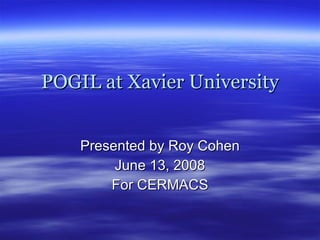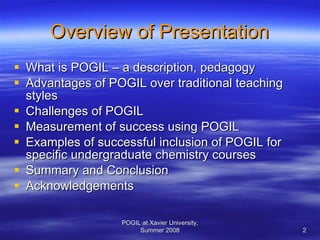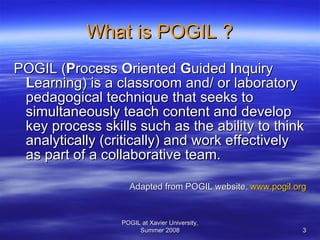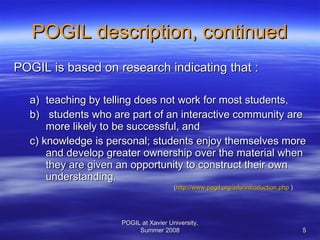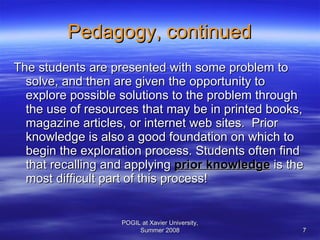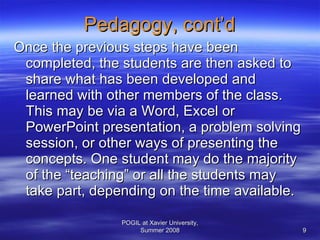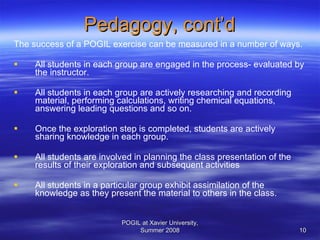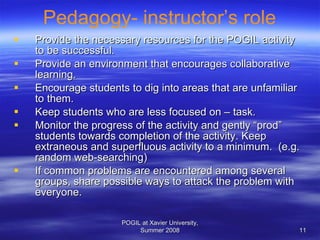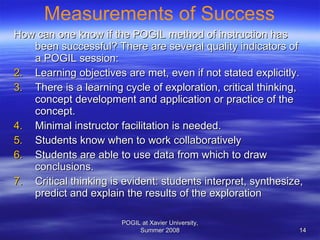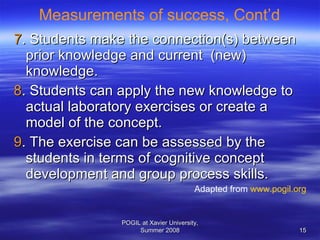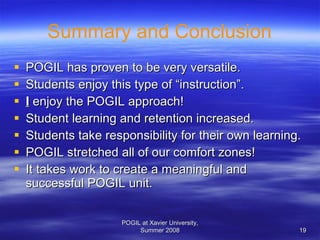Pogil At Xavier University
- 1. POGIL at Xavier University Presented by Roy Cohen June 13, 2008 For CERMACS
- 2. Overview of Presentation What is POGIL ŌĆō a description, pedagogy Advantages of POGIL over traditional teaching styles Challenges of POGIL Measurement of success using POGIL Examples of successful inclusion of POGIL for specific undergraduate chemistry courses Summary and Conclusion Acknowledgements POGIL at Xavier University, Summer 2008
- 3. What is POGIL ? POGIL ( P rocess O riented G uided I nquiry L earning) is a classroom and/ or laboratory pedagogical technique that seeks to simultaneously teach content and develop key process skills such as the ability to think analytically (critically) and work effectively as part of a collaborative team. Adapted from POGIL website, www.pogil.org POGIL at Xavier University, Summer 2008
- 4. Description of POGIL A POGIL classroom or lab consists of any number of students working in small groups on specially designed guided inquiry materials. These materials supply students with data or information followed by leading questions designed to guide them toward formulation of their own valid conclusions - essentially a recapitulation of the scientific method. The instructor serves as facilitator, observing and periodically addressing individual and classroom-wide needs. POGIL at Xavier University, Summer 2008
- 5. POGIL description, continued POGIL is based on research indicating that : teaching by telling does not work for most students, students who are part of an interactive community are more likely to be successful, and c) knowledge is personal; students enjoy themselves more and develop greater ownership over the material when they are given an opportunity to construct their own understanding. ( http://www.pogil.org/info/introduction.php ) POGIL at Xavier University, Summer 2008
- 6. POGIL Pedagogy POGIL pedagogy consists of a student-centered, faculty - facilitated learning situation. The purpose of this type of learning environment is to engage student learners and to make them responsible for the acquisition, application, and dissemination of knowledge. The students are expected to explore a problem, master a technique, or develop a method for solving a particular type of problem, such as a mathematical calculation or, in this case, a chemical principle. POGIL at Xavier University, Summer 2008
- 7. Pedagogy, continued The students are presented with some problem to solve, and then are given the opportunity to explore possible solutions to the problem through the use of resources that may be in printed books, magazine articles, or internet web sites. Prior knowledge is also a good foundation on which to begin the exploration process. Students often find that recalling and applying prior knowledge is the most difficult part of this process! POGIL at Xavier University, Summer 2008
- 8. Pedagogy, contŌĆÖd As the students begin the exploration process they are required to record all their findings, explanations and other relevant information. Once they have discovered relevant information, they are required to apply this information to the problem at hand, and students are also strongly encouraged to extend their knowledge into other areas of application. Application of the knowledge involves a number of cognitive processes: describing information, summarizing information, using the information just gained to perform mathematical calculations, writing chemical equations, and synthesizing possible laboratory investigations that will utilize the information gained. The students in each group discuss these processes with each other until all the students are confident that they all grasp the essential concepts and can explain these concepts to each other, and to the class as a whole. POGIL at Xavier University, Summer 2008
- 9. Pedagogy, contŌĆÖd Once the previous steps have been completed, the students are then asked to share what has been developed and learned with other members of the class. This may be via a Word, Excel or PowerPoint presentation, a problem solving session, or other ways of presenting the concepts. One student may do the majority of the ŌĆ£teachingŌĆØ or all the students may take part, depending on the time available. POGIL at Xavier University, Summer 2008
- 10. Pedagogy, contŌĆÖd The success of a POGIL exercise can be measured in a number of ways. All students in each group are engaged in the process- evaluated by the instructor. All students in each group are actively researching and recording material, performing calculations, writing chemical equations, answering leading questions and so on. Once the exploration step is completed, students are actively sharing knowledge in each group. All students are involved in planning the class presentation of the results of their exploration and subsequent activities All students in a particular group exhibit assimilation of the knowledge as they present the material to others in the class. POGIL at Xavier University, Summer 2008
- 11. Pedagogy- instructorŌĆÖs role Provide the necessary resources for the POGIL activity to be successful. Provide an environment that encourages collaborative learning. Encourage students to dig into areas that are unfamiliar to them. Keep students who are less focused on ŌĆō task. Monitor the progress of the activity and gently ŌĆ£prodŌĆØ students towards completion of the activity. Keep extraneous and superfluous activity to a minimum. (e.g. random web-searching) If common problems are encountered among several groups, share possible ways to attack the problem with everyone. POGIL at Xavier University, Summer 2008
- 12. Advantages of POGIL There are a number of distinct advantages: Student ŌĆō centered form of instruction Students appear to not only like POGIL, but they look forward to it Forces students to utilize prior knowledge Enables students to work collaboratively Encourages research & problem solving Helps ŌĆ£slowerŌĆØ students to be a part of the class Improves retention of material Mimics the ŌĆ£real worldŌĆØ POGIL at Xavier University, Summer 2008
- 13. Challenges of POGIL POGIL is not without challenges: Instructor must prepare well for a successful POGIL experience Assessment of students may be less quantitative and more empirical Many students are unfamiliar with inquiry learning techniques Care needs to be exercised to ensure all require content is covered POGIL may not apply to all types of courses or instructional content Instructor must be cognizant of when to ŌĆ£facilitateŌĆØ the discussion of a particular concept to the class as a whole. POGIL at Xavier University, Summer 2008
- 14. Measurements of Success How can one know if the POGIL method of instruction has been successful? There are several quality indicators of a POGIL session: Learning objectives are met, even if not stated explicitly. There is a learning cycle of exploration, critical thinking, concept development and application or practice of the concept. Minimal instructor facilitation is needed. Students know when to work collaboratively Students are able to use data from which to draw conclusions. Critical thinking is evident: students interpret, synthesize, predict and explain the results of the exploration POGIL at Xavier University, Summer 2008
- 15. Measurements of success, ContŌĆÖd 7 . Students make the connection(s) between prior knowledge and current (new) knowledge. 8 . Students can apply the new knowledge to actual laboratory exercises or create a model of the concept. 9 . The exercise can be assessed by the students in terms of cognitive concept development and group process skills. Adapted from www.pogil.org POGIL at Xavier University, Summer 2008
- 16. Specific Examples Chemistry in Society- for non-science majors. Brainstorming Demographic data evaluation OTC and prescription drug use Energy conversion efficiencies Freshman Chemistry lab Qualitative Analysis Chemical Kinetics POGIL at Xavier University, Summer 2008
- 17. Examples, contŌĆÖd Quantitative Analysis Acid-base equilibria Titration curves Enzyme systems ISE function Mineral content of foods Final research project POGIL at Xavier University, Summer 2008
- 18. Eight levels of investigation With respect to laboratory exercises, the POGIL method was used to help students construct their learning on 8 levels: Historical Context Theoretical Context Importance of Analytes Laboratory aspects Mathematical aspects QA/QC requirements Limitations/ interferences Personal applications POGIL at Xavier University, Summer 2008
- 19. Summary and Conclusion POGIL has proven to be very versatile. Students enjoy this type of ŌĆ£instructionŌĆØ. I enjoy the POGIL approach! Student learning and retention increased. Students take responsibility for their own learning. POGIL stretched all of our comfort zones! It takes work to create a meaningful and successful POGIL unit. POGIL at Xavier University, Summer 2008
- 20. Challenge!! REMEMBER ŌĆō Give a person a fish and you feed them for a dayŌĆ”.. ButŌĆ”ŌĆ”ŌĆ”.. TEACH a person to fish and you feed them for a lifetime!! LetŌĆÖs all teach our students to fish the POGIL way!! POGIL at Xavier University, Summer 2008
- 21. Acknowledgements Much gratitude is due toŌĆ”ŌĆ”ŌĆ”. The American Chemical Society for allowing presentation of this talk. Xavier University for allowing me to ŌĆ£experimentŌĆØ with POGIL to the extent I did & providing the resources for me to be here! Rick Moog of F&M for his encouragement. My students for being willing to be the ŌĆ£test casesŌĆØ for POGIL. Thank You to All of YOU for listening!! POGIL at Xavier University, Summer 2008
- 22. Additional experience Since 2008, POGIL has been implemented in my principles of Physical Chemistry course. For each chapter, the students are given an actual real-world example to investigate. They work in small groups to perform some research on this real-world topic and then attempt to use physical chemical principles to explain the phenomenon. POGIL at Xavier University, Summer 2008
- 23. examples Some examples: Movement of weather systems The use of hyperbaric oxygen chambers Fuel efficiency in the internal combustion engine Bomb calorimetry The way the body maintains blood oxygen levels How a thermos works POGIL at Xavier University, Summer 2008
